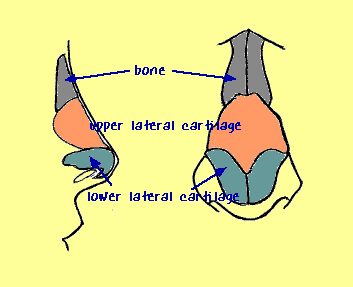| Rhinoplasty |
| Most of the topics on thei site deal with the INTERNAL nose, and sinuses. Rhinoplasty is surgical manipulation of the EXTERNAL nose to create changes visible to the naked eye. It can be either functional (i.e., to improve the function of the nose), or cosmetic (i.e., to improve the cosmetic appearance of the nose; the function is preserved or improved as well). The external nose can be divided into the dorsum and the tip (or lobule). The dorsum has a boney portion superiorly (nasal bones and ascending process of maxilla), and cartilage portion below the bone, but above the tip (upper lateral cartilages). The tip is a tripod configuration with the lower lateral cartilages having lateral crura, and meeting in the middle: at the medial crura. The tip also has a great deal of important soft tissue (fat, skin, and fibrous tissue) that help define the appearance of the nasal tip. |
 |
| Rhinoplasty can be done through either an endonasal ("closed") approach, or external ("open") approach. Both approaches require incisions within the nasal cavity to expose the cartilages. The latter leaves an additional small scar across the columella (midline tissue right above the lip), but it is an important technique for difficult tip, or revision work. Rhinoplasty requires several hours in the operating room, and usually results in nasal/fascial bruising, swelling, and "black eyes." Several days recovery time is required. Some minor swelling can persist for months. |